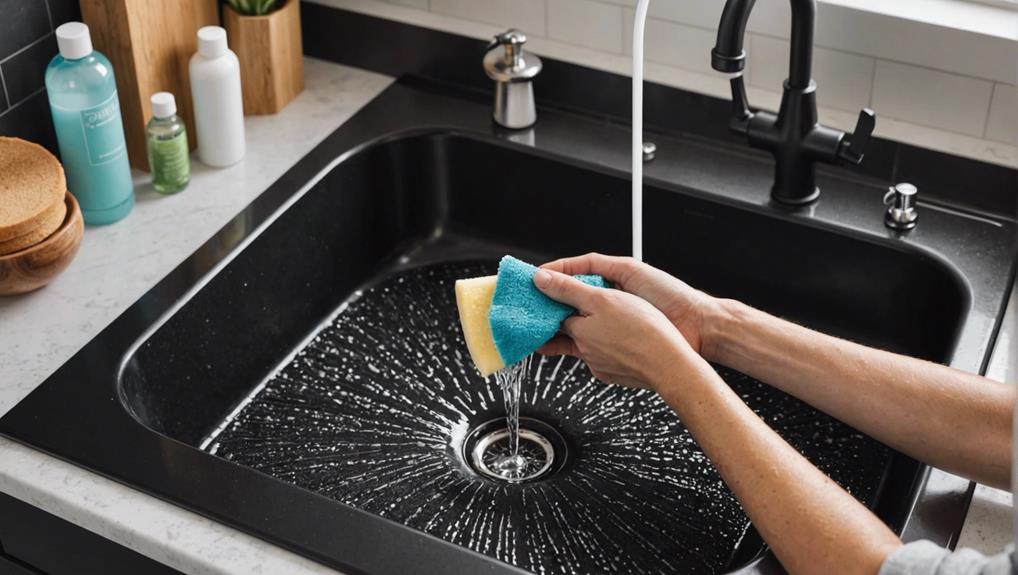
10 Steps to Clean Your Black Kitchen Sink Without Damage
Cleaning your black kitchen sink without damage is easy with these 10 steps. First, gather mild dish soap, baking soda, vinegar, a soft sponge, and a microfiber towel. Empty the sink to prevent scratches, then rinse with warm water. Apply a mild cleaner like dish soap or vinegar, and scrub in circular motions using a nylon brush. Remove limescale with a damp cloth. Rinse thoroughly to remove debris, then dry with a soft cloth to prevent water spots. Maintain cleanliness by rinsing and wiping the sink daily. For more detailed steps, including how to maintain the sink’s shine, keep going.
Key Takeaways
- Use mild dish soap and a soft sponge to prevent scratches and maintain the sink’s condition.
- Apply a baking soda paste for gentle scrubbing and effective stain removal.
- Rinse the sink thoroughly with warm water to remove soap and debris.
- Dry the sink with a microfiber cloth to prevent water spots and maintain shine.
- Avoid using abrasive cleaners, bleach, or harsh chemicals to protect the sink’s surface.
Gather Your Cleaning Supplies
To effectively clean your black kitchen sink, gather mild dish soap, baking soda, vinegar, a soft sponge, and a microfiber towel. Start by organizing your cleaning supplies; having everything at hand streamlines the process and fits well into your cleaning schedule.
Mild dish soap and baking soda are excellent eco-friendly alternatives to harsh chemicals. They’re gentle yet effective, ensuring your sink stays spotless without damaging its finish. Using baking soda and vinegar isn’t only sustainable but also helps in maintaining a healthy home environment. Baking soda acts as a mild abrasive, while vinegar breaks down grime.
Avoid abrasive cleaners, bleach, or harsh chemicals as they can scratch and wear down your sink’s surface over time. Choose a soft sponge and a microfiber towel for the actual cleaning. These materials are gentle, preventing scratches and maintaining the sink’s sleek appearance. Microfiber towels are particularly good for drying and polishing the sink, leaving it streak-free.
Empty the Sink
Before you start cleaning, make sure the sink is completely empty of any dishes or debris. Having a clear sink allows you to clean thoroughly without any obstruction. Remove all dishes, utensils, and any other items sitting in the sink. This will help prevent scratching or damaging the surface during the cleaning process.
Emptying the sink is vital for effective sink organization and maintaining a cleaning schedule. By doing so, you’re guaranteeing that you have access to all areas, making it easier to deal with clogs and prevent rust from developing. Check the drain area for any food particles or debris that could cause future blockages.
| Task | Importance | Benefit |
|---|---|---|
| Remove dishes | High | Prevents scratches |
| Clear debris | High | Avoids clogs |
| Empty drain area | Medium | Ensures thorough cleaning |
Leaving items in the sink could obstruct your cleaning efforts and potentially lead to missed spots, which may harbor bacteria. Being diligent in this first step sets the foundation for a clean and sparkling black kitchen sink. Remember, maintaining a regular cleaning schedule helps in dealing with clogs and preventing rust, ensuring your sink remains in top condition.
Rinse With Warm Water
Once the sink is empty, rinse it thoroughly with warm water to remove any lingering surface debris and food particles. Warm water is your best ally here; its temperature preferences make it highly effective at loosening soap scum, grease, and dirt without being harsh on the sink’s surface.
Make sure to use a steady but gentle stream to cover all areas of your sink. This process not only prepares the sink for a deeper clean but also helps prevent buildup issues in the long run. Remember, warm water can dissolve residues that cold water might leave behind, ensuring a cleaner surface.
To make the process more efficient and environmentally friendly, keep these key points in mind:
- Set a Timer: Limit your rinsing to 2-3 minutes. It’s long enough to be effective but short enough to conserve water.
- Use a Sprayer: If your faucet has a sprayer attachment, use it to target stubborn areas, ensuring thorough rinsing without excessive water waste.
- Reuse Water: Collect the rinsing water in a basin to use for other household tasks like watering plants, emphasizing water conservation.
Apply Mild Cleaner
Many people find that using a mild cleaner like dish soap or a vinegar solution helps maintain their black kitchen sink in pristine condition without risking damage to its finish. Start by selecting a mild cleaner—dish soap or a mix of equal parts vinegar and water are both excellent choices. These products effectively remove dirt, grime, and soap buildup without harming the sink’s surface.
To apply, use a soft sponge or cloth. Dispense a small amount of dish soap onto the sponge or spray the vinegar solution directly onto the sink. Gently work the cleaner into the sink using circular motions, focusing on areas with visible stains or buildup. This cleaning technique ensures thorough coverage while being gentle on the finish.
For product recommendations, consider using well-known, gentle dish soaps like Dawn or Seventh Generation. If you prefer a homemade cleaner, a simple vinegar solution is both eco-friendly and effective.
Once you’ve cleaned the entire sink, rinse it thoroughly with warm water. Make sure no residue from the cleaner is left behind, as this can lead to streaks or buildup over time. Regularly applying a mild cleaner will keep your sink looking immaculate and prevent stains.
Scrub With Nylon Brush
To achieve a deep clean, employ a nylon brush to scrub away stubborn stains and buildup in your black kitchen sink. Nylon brushes are non-abrasive and safe for composite sinks, ensuring you won’t scratch or damage the surface. The key to effective scrubbing is a gentle yet thorough technique that lifts dirt and grime without harsh chemicals.
First, focus on brush maintenance:
- Rinse your brush thoroughly before and after each use to remove any debris.
- Inspect for wear: Replace the brush if you notice frayed bristles, as these can reduce cleaning efficiency.
- Store properly to keep it dry and ready for the next cleaning session.
Second, consider the cleaning frequency:
Regularly scrubbing with a nylon brush can maintain your sink’s appearance and cleanliness. Aim for a weekly cleaning routine to prevent buildup.
Address Tough Stains
After scrubbing with a nylon brush, tackle tough stains by applying a 50% water, 50% vinegar solution to the affected areas. This vinegar solution is an effective limescale remover, perfect for dealing with hard water stains without damaging your black kitchen sink. Gently pour the solution onto the stained area and let it sit for about 5-10 minutes to break down the buildup.
Next, use a soft scrubbing, gentle cleaning approach to remove the stains. Take a soft sponge or cloth and gently scrub the area in circular motions. This method ensures that you address the stains without scratching or damaging the sink surface. If the stains persist, you might want to repeat the process, making sure the vinegar has enough time to work its magic.
Here’s a breakdown of the steps:
| Step | Action | Tips |
|---|---|---|
| 1. Apply Solution | Pour vinegar solution on the stain | Let sit for 5-10 minutes |
| 2. Soft Scrubbing | Use a soft sponge in circular motions | Avoid harsh scrubbing |
| 3. Repeat if Needed | Reapply and scrub again if necessary | Patience is key |
Regular maintenance and prompt action are essential. By addressing tough stains promptly, you’ll preserve the look and longevity of your black kitchen sink.
Remove Limescale
Limescale, a chalky white residue, can mar the sleek appearance of your black kitchen sink, but with the right approach, you can easily eliminate it. Start by mixing a DIY cleaning solution of equal parts water and vinegar. This natural remedy is effective at dissolving limescale without harming your sink’s surface. Pour the mixture into a spray bottle for easy application.
Follow these steps for a limescale-free sink:
- Spray the Solution: Generously spray the water-vinegar mixture onto the affected areas. Make sure all limescale spots are covered.
- Scrub Gently: Use a soft, clean cloth to scrub the sink. Concentrate on the areas with visible limescale, using gentle, circular motions to avoid scratching the surface.
- Wait and Wipe: Allow the solution to sit for about 15 minutes to break down the deposits. Then, wipe the sink with a damp cloth to remove the dissolved limescale.
For stubborn limescale that doesn’t budge with natural remedies, consider professional services or stronger chemical cleaners. Always check the manufacturer’s guidelines before using any chemical cleaner to prevent damage.
Rinse Thoroughly
After cleaning, make sure to remove any loose debris from the sink.
Use lukewarm water to thoroughly rinse away any remaining cleaning solution or residue.
This method helps to prevent streaks and maintains the sleek look of your black kitchen sink.
Remove Loose Debris
Start by thoroughly rinsing your black kitchen sink with warm water to remove any loose debris, ensuring a clean surface for the next cleaning steps. Use a gentle stream of water to wash away food particles, soap residue, and dirt from the surface. This initial rinse is important for effective debris removal techniques and provides essential maintenance tips to keep your sink pristine.
Make sure all visible debris is cleared out before proceeding with the cleaning steps. This step not only sets the stage for a successful cleaning process but also plays a significant role in preventing scratches and providing sink protection. By removing all loose particles, you reduce the risk of abrasive materials causing damage during scrubbing.
Here are three key benefits of this initial step:
- Enhanced Cleaning Efficiency: A debris-free surface allows cleaning agents to work more effectively.
- Scratch Prevention: Eliminating loose particles helps maintain the smooth finish of your black sink.
- Sink Longevity: Regularly rinsing away debris contributes to the long-term health of your sink.
Following these detailed and methodical steps ensures a clean and shiny black kitchen sink, ready for the next stage of cleaning.
Use Lukewarm Water
To effectively rinse your black kitchen sink, use lukewarm water to make sure all debris and cleaning agents are completely removed. The water temperature is important here; lukewarm water strikes the perfect balance. It’s warm enough to dissolve and carry away any leftover soap or grime but not so hot that it risks damaging the sink material.
Start by turning on your faucet and adjusting it until the water feels comfortably warm to the touch. Then, rinse the entire surface of your black kitchen sink. Make sure to reach all corners and edges, as these areas often trap residue. Move your hand or a cloth along the sink’s surface as the water flows, ensuring that every bit of cleaner and dirt is flushed away.
Why lukewarm water? High temperatures can be too harsh on the black finish, potentially causing discoloration or wear over time. Cold water, on the other hand, mightn’t be as effective at removing all residues. By using lukewarm water, you’re maintaining the sink’s appearance and longevity without risking any damage. This step is important in preserving the pristine condition of your black kitchen sink.
Dry With Soft Cloth
Why use a soft cloth to dry your black kitchen sink?
Drying the sink with a soft cloth helps guarantee water spots and maintains its pristine appearance. Microfiber cloths are particularly beneficial due to their gentle nature and superior absorbency levels, ensuring the surface remains scratch-free. Alternative options like cotton or chamois cloths can also be effective, but they may not offer the same level of absorbency and gentleness that microfiber does.
The benefits of using a soft cloth are numerous. Not only does it absorb water efficiently, but it also helps in preventing mineral buildup and limescale stains. By regularly drying your sink, you preserve its sleek black finish, keeping it looking as good as new.
Here are three key reasons to use a soft cloth:
- Prevents Water Spots: Keeps your sink spotless and shiny.
- Minimizes Mineral Buildup: Avoids unsightly limescale and soap scum.
- Protects the Finish: Maintains the sink’s smooth, unblemished surface.
Avoid leaving the sink wet to prevent soap scum, water spots, and potential surface damage. A methodical approach to drying guarantees your black kitchen sink remains a stunning focal point in your kitchen.
Maintain Regularly
Maintaining your black kitchen sink regularly is essential for preserving its pristine look. Stick to a daily routine of rinsing and wiping it down to prevent stubborn stains and water spots.
Always use gentle cleaners and avoid harsh chemicals to protect the sink’s finish.
Daily Cleaning Routine
Regularly rinsing your black kitchen sink with warm water after each use is essential to prevent stains and buildup. This simple habit forms the foundation of effective sink maintenance and helps maintain the sink’s pristine appearance.
It’s important to establish a consistent cleaning frequency to keep your sink in top condition.
After rinsing, take a soft cloth and wipe down the sink to remove any remaining food particles or soap residue. This step ensures that no debris is left to cause staining or odors. For best results:
- Use a soft cloth: Choose a soft material to avoid scratching the sink’s surface.
- Wipe thoroughly: Focus on all corners and edges to make sure no spots are missed.
- Immediate action: Address spills and residues promptly to prevent them from hardening.
Next, dry the sink thoroughly with a microfiber cloth. This not only prevents water spots but also maintains the sink’s glossy finish.
Avoid leaving dirty dishes or standing water in the sink, as these can lead to stubborn stains and unpleasant odors over time.
Prevent Stubborn Stains
To prevent stubborn stains from setting into your black kitchen sink, promptly address any spills or residues as soon as they occur. Regular maintenance is essential for stain prevention and long-term care. Begin by rinsing your sink daily with warm water to remove any food particles or soap residue that might cause discoloration. Use a soft cloth to wipe down the surface, ensuring that no debris is left behind. This simple daily routine goes a long way in avoiding stubborn stains.
Quickly remove food debris and soap residue to reduce the chances of stains forming. Don’t let dishes or standing water sit in the sink for extended periods, as this can lead to discoloration and tough-to-remove stains. Maintaining a habit of emptying and cleaning the sink after each use is one of the best maintenance tips you can follow.
Consistent care with gentle methods will help preserve the pristine appearance of your black kitchen sink. By integrating these practices into your daily routine, you’ll be actively avoiding discoloration and ensuring that your sink remains looking new. Remember, a little bit of regular attention can prevent a lot of long-term problems.
Use Gentle Cleaners
Maintain your black kitchen sink in top condition by opting for gentle cleaners that won’t damage its finish. Regularly using mild, natural cleaning solutions will help preserve the sink’s appearance while being kind to the environment. Avoid harsh chemicals like bleach and ammonia, which can strip the sink’s finish and cause lasting damage.
For an eco-friendly approach, consider these natural cleaning solutions:
- Mild Dish Soap: Mix a small amount with warm water to create a gentle cleanser that effectively removes daily grime without harming the finish.
- Baking Soda: Sprinkle it over the sink, then scrub gently with a soft cloth or sponge. Baking soda’s mild abrasive nature helps lift stains without scratching.
- Vinegar: Combine equal parts vinegar and water in a spray bottle. This solution disinfects and removes water spots, leaving your sink sparkling clean.
Rinse the sink thoroughly after cleaning to remove any residue and prevent buildup over time. By maintaining your black kitchen sink regularly with these gentle, eco-friendly alternatives, you can prolong its lifespan and keep it looking new.
Making these simple adjustments ensures your kitchen remains both beautiful and sustainable.
Frequently Asked Questions
How Do You Clean a Black Kitchen Sink?
To maintain a black kitchen sink, use mild dish soap and water with soft cleaning tools. For effective stain removal, quickly address food stains and avoid abrasive cleaners. Regular maintenance guarantees your sink stays pristine and damage-free.
Is a Black Kitchen Sink Hard to Keep Clean?
No, a black kitchen sink isn’t hard to keep clean. With daily maintenance and prompt removal of common stains, hot soapy water and a soft cloth are all you need to maintain its sleek appearance.
How to Protect a Black Sink From Scratches?
To protect your black sink from scratches, use mats or sink protectors and regularly maintain it. Avoid abrasive scrubbers, and be cautious with heavy objects. Regular maintenance prevents dirt buildup that can cause scratches over time.
Can I Use Bleach in a Black Sink?
No, you shouldn’t use bleach in a black sink. Instead, consider bleach alternatives like dish soap, vinegar, or baking soda. Always follow safety precautions to prevent damage and maintain your sink’s appearance and longevity.
Conclusion
You’ve now mastered the art of cleaning your black kitchen sink without causing any damage. By gathering your supplies, rinsing with warm water, applying a mild cleaner, and scrubbing with a nylon brush, you guarantee a thorough clean.
Removing limescale, rinsing thoroughly, and drying with a soft cloth keeps your sink looking pristine. Regular maintenance will make this process even easier.
Stick to these detailed steps, and your sink will always shine like new.



Leave a Reply